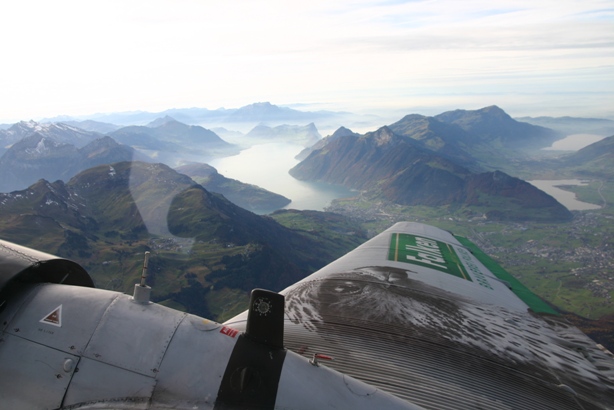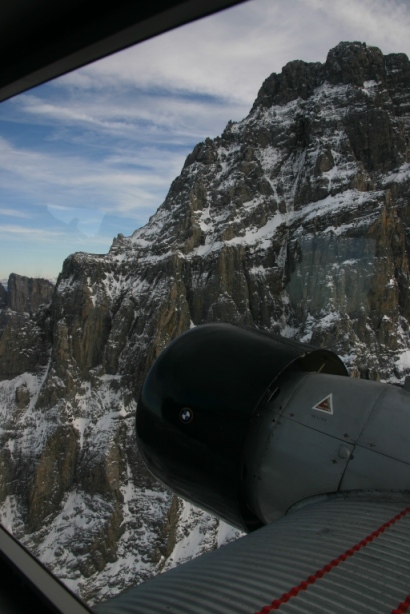02.10.2011: I returned yesterday from two weeks of vacation in Sardinia, just what I needed after a busy summer and autumn. We went there by car, so no flying. Today however I was back in the air, as it was a beautiful day, with some haze and even fog in the plains, but unlimited visibility above 6’000 ft. We just did a little tour of about 1 1/2 hours into the mountain, looking for snow, but at 11’000 ft it was still + 9 degrees, so no traces of winter yet.
22.10.2011: First of all I got a new PC, so I had to re-install the web access to my provider to be able to upload updates to my website. Then I have been pretty busy at work, so I managed to go flying only once over the last three weeks. Today I went to the airport as I just had to see the lifts that have arrived last week. My plane is parked outside since a year, but the club decided some months ago to install two lifts to get tow more planes into the hangar. Luckily a Tecnam and my SportCruiser are the two on the waiting list that get the spots. There is actually a WACO ahead of my plane on the list, but a biplane can’t go on the lift, as can be seen on the picture below.

When the lift is raised the fuselage goes between two roof beams, so we carefully tried the lift to see how everything fits. We used the SportCruiser of the club, as it is parked in the same hangar, but discovered that the lift cannot be raised high enough for an Archer II/III to be parked underneath, as the elevator of the SportCruiser hits the beams. There are around 10 to 15 cm missing. I will therefore have to make a small ramp to rise the nose wheel, so that the elevator is lowered some 20 to 30 cm, which then allows us to raise the plane higher up. We tried it out by putting some pieces of wood underneath the nose wheel, and it worked.
27.10.2011: I took half a day off to go and try the lift again at the airport. Here first of all a picture of the basic design of the lift. It is based on a vertical column made out of two pretty sturdy I-beams which are resting on a small I-beam parallel to the wall and two I-beams that protrude out onto the floor. All of this forms the basic structure, which according to the designer is so heavy that it does not tip over when a plane is put on the lift. That’s one of the key features, the lift does not need any special foundation or fixing to either the wall or the ground.
To the vertical column a kind of sledge is attached, which is lifted by means of an electric motor who turns a jackscrew. This then moves the sledge up-, respectively downwards, depending on the direction the motor turns. The basic idea is that in case of malfunctioning the lift just stops, but can’t drop as if cables were used. Also the motor only requires little power to lift the plane.
The sledge then holds three arms, which end in some kind of pans onto which the wheels of the plane go. The pans are pretty long, and the two outer ones can be adjusted to the track width of the main gear of the plane to be lifted, so most planes can go onto the lift with only minor adjustments. The maximum design weight would allow us to putt anything up to a Mooney onto the lift, even with full fuel, so with the SportCruiser or the Tecnam we are well below even half of the maximum design weight.
The lift is operated from a small control box, which has a key, so once the plane is up nobody can get to it.

When the lifts were installed the the roof structure hat to be modified, as some diagonal beams would have interfered with the fuselage. On the second lift one of the cross beams has not been removed, and there were also some old wooden poles stored in the roof structure (since probably decades), so we first had to remove all of that.

Urs, the club’s infrastructure manager (with the chainsaw) and Christian, the owner of the Tecnam cut everything we removed to small pieces, to be discarded.

We then tried the Tecnam first, which went up without any problem. The plane is protected against rolling backwards by using chocks, and also attached at the front with a safety belt.

Below a picture of the SportCruiser on the second lift, one can see that the nose is raise slightly. I built a temporary wooden ramp that raises the nose wheel by 16 cm, but that proved to be too much so the final one I will make next week will only be 8 cm high.

Here a picture of my plane in the raised position….

…and here the same with the Archer III parked underneath.

29.10.2011: Nearly five years ago I received a voucher for my birthday for a flight in one of the Junkers Ju-52 operated by Ju-Air, but due to my frequent trips abroad and the fact that Ju-Air flights are typically booked out already in February for the whole season I never got to use it. Today however I finally managed to get a seat on one of the flights.
Ju-Air is a private association that was founded in 1982 when the Swiss Air Force retired it’s three Ju-52 acquired in 1939. By that time the aircraft were already 43 years old, but still in good flying condition. Since nearly 30 years Ju-Air now operates these aircraft on public sightseeing flights with considerable success. In 1990 they even acquired a fourth aircraft, one which was built in Spain in 1949 under licence from Junkers. With that one they own more than half of the world’s airworthy Ju-52 fleet. The aircraft still use their original BMW 132A/3 engines with 650 hp each at 2’000 rpm. They only operate them at reduced power, with the result that they sound more like marine diesels than aircraft engines.
The aircraft are operated with 17 passengers plus a crew of three (pilot, co-pilot and flight attendant). The fuselage of the Ju-52 is relatively narrow, meaning they use a seating arrangement that gives everybody a window seat.
Today we had pretty heavy fog in the morning (nothing unusual for late October), so the flight that was scheduled for 14:30 was delayed for about an hour, but I guess that’s to be expected from an airline that operates solely under VFR.
We were waiting on the tarmac of Dübendorf airfield, a military airbase that today is home of some transport planes only, waiting for our plane to land from a previous flight. I noticed that all the passengers getting off the plane had huge smiles on their faces, so quite a promising start. The flight took place with HB-HOP, the former A-703 of the Air Force, which flew first on the 1st August 1939.

We got an airline style safety briefing, including the information that once the fasten your seatbelt sign is switched off passengers are free to roam the cabin (as far as possible as it is quite narrow), and also to walk up to the cockpit. Nothing like reinforced cockpit doors or all the other safety stuff of modern air travel…

We took off at around 15:30 and the pilot immediately turned south towards the lake of Zurich and the Alps. During climb the speed was around 140 km/h, respectively 75 kts, cruise is 160 km/h or 85 kts and during the decent we reached a breathtaking 200 km /h, or 105 kts. On the picture below some remaining traces of the morning fog are visible over the lake, but higher up the view was excellent.

The cockpit is still pretty much in it’s original state, just a box has been added in rear of the throttles for the radios and the transponder.

Here a view towards the Rigi and Lucerne. On top of the engine nacelle one can see the fuel gauge (the round dial installed in the black “thing”). They can carry around 1250 litres of fuel per wing, which gives around 6 hours of autonomy at a fuel burn of 380 l per hour. That’s not too bad for 17 passengers, and they even managed to get the engines certificated for automotive gasoline.

We then flew into the mountains, first toward Engelberg and then east towards the Glarner Alps. They only climbed to 10’000 ft, I guess that’s because, according to the newest regulations, they would have to carry oxygen if they’d operate any higher.


Below a view at the rudder pedals, again probably still the original ones from 1929.


The captain flew quite close to some of the nearly vertical mountain flanks, to the great excitement of some of the German passengers. I’m quite used to flying in the mountains, but most people aren’t.

Here a view from the rear of the cabin towards the cockpit, the corrugated sheet metal design is also visible from the inside.

After passing the Tödi and the Glärnisch mountain we turned back towards Dübendorf, here with a nice view over the Walensee.

Below some final pictures take after landing, definitely a unique airplane and a very nice experience. I enjoyed it not to be the pilot for once, just looking outside and taking pictures. Definitely a trip worth taking.

On this picture the size of the aircraft can be seen, it has a wingspan of around 30 m, only 5 m less than an Airbus A-320. The MTOM is however only 10’500 kg, or one seventh of the one of an A-320.

Some time ago there was a rumour that Ju-Air might retire the aircraft soon, the last date I heard is 2014 (by then they are 75 years old), so those who want to fly with them should hurry up.